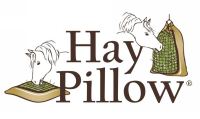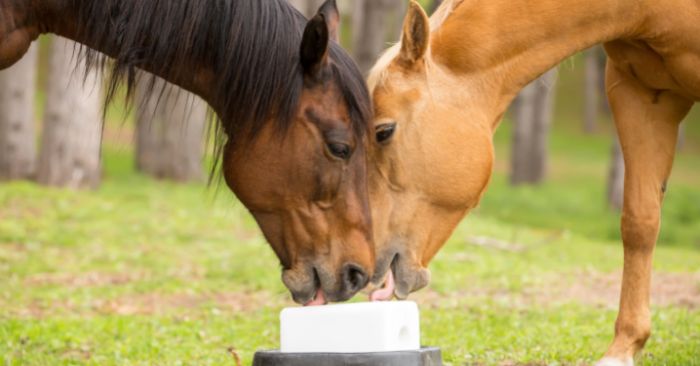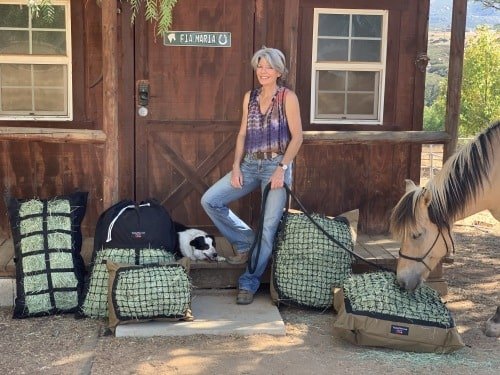Why Horses Need Salt & Why Salt Blocks Are Not Enough
Salt supplementation is required for optimum health - regardless of the season. It is imperative to: 1) Ensure the minimum requirements are consumed daily in feed; 2) Provide an ample supply of fresh water; and 3) Offer an additional free choice supply of either loose salt or a white salt block. Read on to learn why, when and how much.

Why Horses Need Salt
- Salt is an electrolyte - and the most crucial mineral in the equine diet and helps to maintain optimum pH levels.
- Sodium levels are measured by the brain, which signals the horse to drink. If sodium blood concentration is low, the signal to drink water will be greatly diminished. Why? Drinking water would further dilute the crucial sodium levels in bodily fluids.
- Correct sodium balance in the horse is necessary for proper thirst response and body fluid equilibrium.
- The horse's body is approximately 70% fluids, which include water and electrolytes.
- Salt is necessary for the production and secretion of bodily fluids such as sweat, saliva, intestinal tract fluids, urine and mucus.
- Sodium is also necessary for proper nerve, digestion and muscle function (including the heart and intestines).
Why You Shouldn’t Rely Solely on Salt Blocks
- It is impossible to monitor daily consumption.
- Horses rarely spend the time necessary licking a salt block to meet their daily needs. This could require a horse to bite off and eat chunks to do so.
- White salt blocks are optimum as a supplemental palatable source of salt. Red mineral salt blocks can be bitter and deliver only a very minute amount of additional minerals. Mineral requirements should be met in the core diet.
- A salt block weighing 4 pounds would need to be consumed in 3 weeks to 2 months depending on the weather in order to meet the minimum requirements for an 1100 pound idle horse.
Free-Choice Minerals - Another Mystery Calculation
If you top-dress free choice minerals, you will need to calculate how much actual sodium is being provided.
When & How to Feed Salt
The most convenient method is to include it in daily supplements (bucket feed) with enough of the carrier to achieve palatability. I prefer soaked hay pellets with no binders as a carrier for supplements.
Whether idle or working, free choice loose salt or white salt blocks should be available at all times to allow the horse to compensate for additional needs.
How Much?
An average 1,100 pound idle horse (not in work) requires:
- Minimum of 2 tablespoons (1 ounce/36 grams) of salt (sodium chloride) daily.
- Horses lose at least this amount daily in bodily fluids.
- Minimum requirement can increase 2 to 3 times in warmer weather.
- Slightly more than a ½ teaspoon per 100 pounds of body weight for idle horses
- Increasing up to 1 to 1½ teaspoons in warmer weather respectively.
- An idle horse, that is not in work, should perspire - but sweat may not be visible.
- If your horse doesn’t sweat and/or drink enough water, feeding adequate salt may alone resolve the issue.
Horses in work should receive additional salt or a more complete electrolyte supplement.
How to Calculate the Amount of Salt in the Current Diet
You can skip this step if your horse's diet consists of baled hay or pasture and a supplement with no sodium added. In that case, you must supplement to meet your horse's minimum requirements.
Most complete feeds and many supplements contain some salt (sodium chloride).
It is prudent to base the amount you will supplement by calculating the elemental grams present in the diet and subtract that from the total amount you wish to supplement.
To accomplish this:
- Calculate the total grams of salt you wish to provide.
- Subtract the salt (sodium chloride) contained in your current complete feeds or supplements. (Note: Feed labels may list this as salt or sodium. Labels may not list either if the amount is less than label regulations require for listing.
Converting Feed & Supplement Labels
Nutritional analyses are listed by using a variety of measurements: grams, parts per million (ppm) and percentages (%). If I could be granted one wish in the feed industry - it would be standardizing the measurement to grams on all labels.
To recap - for an 1100 pound idle horse:
The minimum amount of salt to be fed is 36 grams (1 ounce), which provides approximately 14 (elemental) grams of sodium and 22 (elemental) grams of chloride.
If the analysis provides ppm or percentages you need to convert the amount to grams. You can do so by using these links:
- Parts per million to grams converter: https://www.unitconverters.net/concentration-solution/part-million-ppm-to-gram-liter.htm
- Percentages to grams converter: https://www.convertunits.com/from/percent/to/gram/kilogram
The above converters calculate the number of grams per kilogram. The basics of gram measurements:
- 1000 milligrams = 1 gram
- 1000 grams = 1 kilogram = 2.2 pounds
Calculate Complete Feeds Based on the Amount You Feed
All too often, guardians are under the impression that by feeding small amounts of a complete feed, their horse’s daily sodium, vitamin and mineral requirements are being met. Pay close attention to the nutritional analysis PER pound.
Salt - An Inexpensive Insurance Policy
Helpful How To Resources
- Can Horses Eat More Hay Without Weight Gain? The Surprising Factors
- Grass Hay vs Pellets, Cubes & Chopped Hay – Pros & Cons
- Are You a Prisoner of Feeding? Here's How I Broke Free
- 6 Great Reasons to Feed Your Horse from Ground Level
- 7 Slow Feed Dos and Dont's for Horses
- Sugar Content of Pasture & Hay: Q & A with Katy Watts, Founder of Safergrass.org
- 7 Easy Ways to Help Prevent Colic
- Causes of Equine Ulcers – 7 Stress Factors & Solutions
- Never Exercise Horses on an Empty Stomach...Ever
- Why You Shouldn't Transport Horses On An Empty Stomach
- Keeping Horses Warm Naturally – Internally and Externally
- Why Most Horses Prefer to Eat Outside
References:
- Kellon, E.(2018, June 24) Salt to the Rescue. Retrieved from https://drkhorsesense.wordpress.com/2018/06/24/salt-to-the-rescue/
- Kellon, E. (2012, August 21). Equine Electrolytes, Exercise, and the Heat. Retrieved from https://thehorse.com/118025/equine-electrolytes-exercise-and-the-heat/
- Layton, C. (2020, January 17) Feed Your Horse Salt. Retrieved from https://balancedequine.com.au/feed-salt/
- Woodbury-Kuvik, P. (2012, April 21). Measure Salt. Retrieved from: https://desertequinebalance.net/Files/measure-basic-minerals.html
- Kentucky Equine Research Staff. (2014, August 6) Checking for Dehydration in Horses. Retrieved from https://ker.com/equinews/checking-dehydration-horses/








1 Comment -
Erika Smith Royal •
I am looking for permission to reprint your article on Why Horses Need Salt in the June edition of Arizona Real Country Magazine.
Thanks in advance,
Erika Smith Royal
Editor
ArizonaRealCountry.com